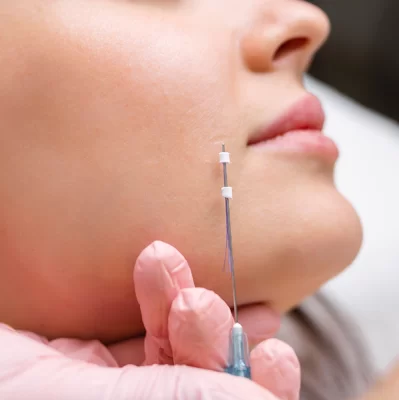Lifting threads: how long does the effect last?
- How long does the effect of thread lifting last?
- How do lifting threads provide a long-lasting effect?
- What influences the longevity of the effects after a thread lifting procedure?
- How does the type of thread used affect the duration of the effect?
- When do the first effects appear?
- How can you prolong the effects of thread lifting?
- When should the thread lifting procedure be repeated?
The effects of the treatment with lifting threads usually last from 12 to 24 months. However, it is important to remember that their durability is individual and depends on many factors. Some people may enjoy the results for up to 3 years, and in rare cases up to 6 years. Although the threads gradually dissolve and natural aging processes continue, the overall condition of the skin remains significantly improved for a long time. This is possible due to the intense stimulation of tissue regeneration induced by the procedure.
Thread lifting procedure provides long-lasting results thanks to its dual mechanism of action. Immediately, the threads create a framework under the skin, giving a quick lifting effect. However, the key to the durability of the effect is bio-stimulation. Threads made of absorbable materials, such as PDO or PLLA, activate fibroblasts. This stimulates the skin to increase collagen and elastin production – a process known as neocollagenesis. The newly formed collagen fibers gradually wrap around the threads, which eventually completely degrade through the process of hydrolysis. The collagen formed in this way creates a lasting scaffold. Long-term, it regenerates the skin, significantly improving its density, tightness, firmness, and elasticity.
The long-term results of thread lifting are influenced by many factors, including:
- patient's age,
- individual skin characteristics,
- lifestyle and natural aging process,
- type and quantity of threads used,
- precision of the procedure,
- initial skin condition, including its firmness before the procedure.
To maximize the longevity of the achieved results, strict adherence to post-procedural recommendations is essential.
The durability and effects of lifting treatments mainly depend on the type of threads used. PDO threads dissolve after 6-12 months, and the effects of their action last up to 2 years. PLLA and PCL threads degrade more slowly, with the results of their action lasting up to 3 years.
The structure of the threads is also essential. Barbed threads, due to their hooks, provide immediate and strong mechanical lifting. Smooth threads, such as MONO or SCREW, support tissues and induce intense bio-stimulation.
Currently, in aesthetic medicine, absorbable threads that completely dissolve are dominant. Previously, non-absorbable threads were used, which have been replaced by more modern and safer solutions.
Thread lifting procedure has a dual effect. Immediately after its completion, a noticeable mechanical effect of lifting the skin is observed. It improves the oval shape of the face, effectively reduces so-called "hamster cheeks," lifts the eyebrows, giving the eyes a trendy "foxy eyes" look.
However, full rejuvenation of the skin occurs over time. This process progresses gradually, usually over a period from 2 weeks to several months. During this time, the skin undergoes intensive regeneration thanks to tissue stimulation, leading to smoothing of wrinkles, including nasolabial folds and "marionette lines." The final result is natural and harmonious.
To maintain excellent results of thread lifting, strict adherence to post-procedural recommendations is crucial. Gentle skincare is essential. During the recovery period, you should:
- Avoid intense physical exertion,
- Avoid visits to the sauna,
- Avoid visits to the pool,
- Avoid facial massages for the first few weeks,
- Avoid any heat treatments, especially in the area where threads were applied,
- Remember to follow a balanced diet that supports skin regeneration.
Your doctor may also recommend using special strips and kinesiotaping. Both methods effectively stabilize tissues and support wound healing.
The decision to undergo a thread lift procedure again is always an individual matter. Although the results of this procedure typically last from 1 year to several years, a repeat procedure is often considered when the effects start to diminish – usually after 6-18 months. The exact timing of the repeat procedure, however, depends on many factors such as the individual skin aging process, the type of threads used, and the patient's expectations.
It is always important to consult with an experienced specialist before deciding on another procedure. The doctor will carefully assess the skin condition and rule out any contraindications to the procedure. Threads should not be used in cases of:
- Pregnancy,
- Breastfeeding,
- Active skin infections,
- Autoimmune diseases,
- Uncontrolled diabetes,
- Cancerous growths,
- Allergy to thread components,
- Taking anticoagulant medications.

